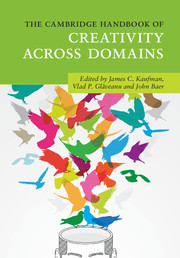Book contents
- The Cambridge Handbook of Creativity Across Domains
- The Cambridge Handbook of Creativity Across Domains
- Copyright page
- Dedication
- Contents
- Figures
- Tables
- Contributors
- Acknowledgments
- Part I Creativity and Domain
- Part II Creativity in the Traditional Arts
- 5 The Creativity of Literary Writing
- 6 Creativity in the Visual Arts
- 7 The Creation and Aesthetic Appreciation of Architecture
- 8 Photography and Creativity
- 9 The Constricted Muse
- 10 Musical Creativity
- 11 Dance
- Part III Creativity in the Sciences
- Part IV Creativity in Business
- Part V Newer Domains for Creativity Research
- Part VI Creativity in Everyday Life
- Part VII Conclusion
- Index
- References
10 - Musical Creativity
from Part II - Creativity in the Traditional Arts
Published online by Cambridge University Press: 15 September 2017
- The Cambridge Handbook of Creativity Across Domains
- The Cambridge Handbook of Creativity Across Domains
- Copyright page
- Dedication
- Contents
- Figures
- Tables
- Contributors
- Acknowledgments
- Part I Creativity and Domain
- Part II Creativity in the Traditional Arts
- 5 The Creativity of Literary Writing
- 6 Creativity in the Visual Arts
- 7 The Creation and Aesthetic Appreciation of Architecture
- 8 Photography and Creativity
- 9 The Constricted Muse
- 10 Musical Creativity
- 11 Dance
- Part III Creativity in the Sciences
- Part IV Creativity in Business
- Part V Newer Domains for Creativity Research
- Part VI Creativity in Everyday Life
- Part VII Conclusion
- Index
- References
Summary
Music is a paradigmatic domain of creative activity, culturally ubiquitous and manifested in a multitude of ways. Here I explore music as a domain of human creativity – both as a specific “content” domain informing productive aspects of musical creativity, and as a domain of mind, whose evolutionary backstory constrains the reception of music. In discussing the phylogenetic emergence of human musicality, I highlight possible tensions in the creative dynamic between novelty and canalized aesthetic preferences. A richer discussion of the creative process in music follows, illustrated by anecdotal and interview accounts as well as laboratory and archival studies, which collectively have shed substantial light on contemporary theories of creativity. I close by discussing the role of socio-cultural factors in musical creativity and some possible future directions for research.
- Type
- Chapter
- Information
- The Cambridge Handbook of Creativity across Domains , pp. 161 - 180Publisher: Cambridge University PressPrint publication year: 2017
References
- 6
- Cited by



